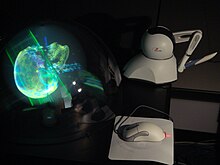Volume display
A volumetric display ( Engl. Volumetric display ) is a graphical display ( 3D display ).
It enables a visual representation of an object in all three dimensions. In contrast to conventional 2-dimensional displays, which can only simulate spatial depth through various visual effects, volume displays are therefore able to reproduce 3-dimensional images that can be viewed from all sides. The pixels in 2-dimensional space previously used to describe images are replaced by voxels in such displays that cover a well-defined 3-dimensional space. Each voxel can generally display its own color and brightness.
more details
With a volume display, physical mechanisms are used to display points of light floating in space, e.g. B. via luminous voxels in gas, fog or on a rapidly rotating frosted glass disc or helix. Other solutions use multiple LCDs .
One of the principles of a volume display is to move the projection surface so that it covers an entire volume . If this happens fast enough and, depending on the position of the surface, other content is projected, the human eye, due to its inertia, combines everything into a closed 3D image.
One approach is to use a helically wound surface, shaped like a turn of an Archimedean screw . This surface is mounted vertically and rotates around a vertical axis. A 2-D projector projects the image onto a sector of this area, i.e. onto an inclined area that is higher or lower depending on the current angle of rotation. The projector must project the information on this section, synchronized with the rotation, that matches the respective height points on the inclined surface. Scottish TV pioneer JL Baird applied for a patent for his volumetric 3D and color TV system in 1941. Current laboratory systems (Japan, UK) may use a. Laser light sources.
Recent developments
Researchers at the University of São Paulo in Brazil and the University of British Columbia in Canada developed the spherical display Spheree, which enables users to view and interact with three-dimensional objects. In terms of its external appearance, at first glance it is reminiscent of a snow or crystal ball.
The new technology was demonstrated at SIGGRAPH 2014, the 41st International Conference and Exhibition on Computer Graphics and Interactive Technologies, which took place from August 10 to 14, 2014 in Vancouver. There the participants were able to control a 3D animation in which a train drove around an animated house in the snowfall.
This interactive visualization is made possible by eight pocket-size projectors (pico projectors), which are housed in the foot part of the sphere, as well as powerful software that coordinates the interaction of the individual projectors and ensures automatic calibration of the projectors. It is thus possible to seamlessly combine the resolution and brightness of the individual projected images in such a way that a decline in quality is prevented and a uniform representation of a 3D animation is possible almost everywhere on the spherical surface. This is achieved primarily through the use of a webcam, which determines the position of the individual projections and specifically calculates their contribution to the overall image in the sphere.
The display uses six infrared cameras to enable interaction with people in the area. They track the movement of the audience, who are marked with the help of a sensor. Using the data from the cameras, a computer can constantly correct the perspective of the virtual scene in relation to the position of an observer. In addition, a Leap Motion interface enables control and interaction of 3-D scenes and animations with gestures. This makes it possible, for example, to start an animation or move it back and forth.
Web links
- Bollograph , volume display with up to 250 × 250 × 1000 voxels
- VisualCube , volume display consisting of 6 × 6 × 6 voxels

